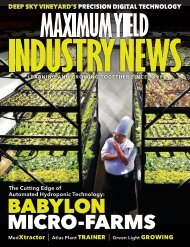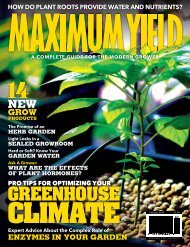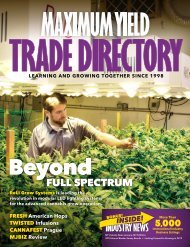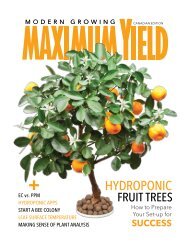Maximum Yield Modern Growing | Vol. 21 Issue 01 2019
Developed more than 50 years ago, NFT systems can quickly produce large yields of produce with minimum water usage. However, these systems can present problems — for both home and commercial growers — if they aren’t monitored properly. Also inside: Hydro Nutrient Management, The Importance of Growroom Hygiene, Maintaining and Troubleshooting pH Control Systems, and more.
Developed more than 50 years ago, NFT systems can quickly produce large yields of produce with minimum water usage. However, these systems can present problems — for both home and commercial growers — if they aren’t monitored properly.
Also inside: Hydro Nutrient Management, The Importance of Growroom Hygiene, Maintaining and Troubleshooting pH Control Systems, and more.
Create successful ePaper yourself
Turn your PDF publications into a flip-book with our unique Google optimized e-Paper software.
One of the main advantages of NFT, apart from the cost and labor savings of not<br />
requiring large volumes of a growing substrate, is it allows production of salad greens,<br />
lettuce, and herbs without the risk of grit contamination which can occur in soilless<br />
substrate systems. NFT systems may incorporate heating or cooling of the nutrient solution<br />
as is required for year-round cropping and allow a very ‘clean’ system to be run,<br />
with sterilization of equipment between crops if necessary.<br />
The main disadvantage of NFT is that power outages, which halt the continual flow of<br />
nutrient, can quickly result in crop death, particularly under warm growing conditions.<br />
Top: Multi-level NFT systems maximize<br />
growing space.<br />
Bottom: Vertical systems are ideal for<br />
lightweight NFT channels.<br />
“NFT systems may seem more complex<br />
than substrate-based types of hydroponics,<br />
however, they are extremely flexible with<br />
regards to size, design, and equipment.”<br />
FLEXIBILITY OF NFT SYSTEMS<br />
NFT systems may seem more complex than substrate-based types of hydroponics,<br />
however, they are extremely flexible with regards to size, design, and equipment.<br />
A small basic system can comprise a single growing channel for production of a<br />
few plants, a plastic bucket or bin for a nutrient reservoir, and a small aquarium<br />
pump to circulate the nutrient solution. NFT growing<br />
channels with a flat base profile can be purchased, however,<br />
over the decades many innovative materials have been<br />
used where these are not available. These include rainwater<br />
down pipes, large diameter bamboo, channels formed from<br />
timber, metal, or concrete and lined with plastic and long<br />
rolls of plastic film itself folded into channels. These types of<br />
basic NFT systems require manual checking and adjustment<br />
of the electrical conductivity (EC) and pH of the nutrient<br />
solution, and regular water level adjustments.<br />
Commercial NFT systems are typically far more automated<br />
than hobby systems and make use of electronic and<br />
computer-controlled EC, pH adjustment, and float valves to<br />
replace water used in the system. Advanced commercial<br />
NFT systems may also utilize dissolved oxygen and solution<br />
temperature measurements to monitor these root zone<br />
variables. An NFT-based growing operation often has both<br />
seedling and finishing NFT benches through which the plants<br />
progress during production. Seedling systems have plants at<br />
a much higher density, which are moved to a wider spacing<br />
in the finishing system to maximize the growing area inside<br />
greenhouses. Other NFT systems include moveable channel<br />
systems where the distance between adjacent channels is<br />
increased as the plants grow. Vertical NFT systems are also<br />
popular and optimize growing space for lower-light crops<br />
such as lettuce and some herbs. NFT systems can also be<br />
installed outdoors or under basic shade covers.<br />
IMPORTANT NFT FACTORS TO CONSIDER<br />
Constructing and running a successful NFT system is reliant<br />
on a few vital factors. These include slope, flow rate, nutrient<br />
reservoir size, channel volume, and pump capacity. For those<br />
purchasing an NFT system kitset, choose a reliable supplier with<br />
a good reputation and these variables will already have been<br />
factored into the design. For home-built systems, some consideration<br />
needs to be given to all components and equipment. The<br />
channels must be positioned on a slope so the nutrient solution flows steadily down at<br />
a good flow rate, which for most systems is around 0.26 gallons/minute. Some systems<br />
allow the channel slope to be adjusted and increased as the root system develops and<br />
expands inside the channels, ensuring nutrient ponding does not occur. The dimensions<br />
of the NFT channels are dependant on the type of plants being grown. Small<br />
lettuce and herbs may be grown in standard NFT channels of four inches wide and two<br />
inches high made from UV stabilized FDA approved high density polyethylene. Larger<br />
plants like cucumbers and tomatoes require a wider and taller channel to accommodate<br />
their considerably larger root system.<br />
34<br />
<strong>Maximum</strong> <strong>Yield</strong>

















